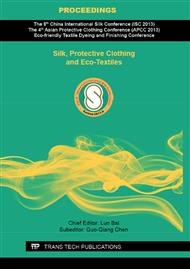p.187
p.191
p.195
p.199
p.205
p.211
p.215
p.221
p.225
Cognitive Evaluation of Silk Fabrics Based on Physiological Signal
Abstract:
The most important situation of textile companies is to design products which much more meeting the consumers feeling. In this paper, 4 kinds of silk fabrics were taken as the objects, 4 physiological targets were used such as electromyography (EMG), skin resistance (SC), skin temperature (ST), and respiration (Resp) from tactile and visual cognition. The aim of this research is to find out the physiological evidence of consumers in tactile and visual for textile. As the result shown that, accompanied by touch and watch, skin resistance and electromyography have obvious regularity undulation, and there were large discrepancy in each objects, however, skin temperature and respiration had little correlation. In a word, physiological indicators can be used as silk fabrics cognitive quantitative evaluation basis in tactile and visual more intuitively and conveniently.
Info:
Periodical:
Pages:
205-208
Citation:
Online since:
September 2013
Authors:
Keywords:
Price:
Сopyright:
© 2013 Trans Tech Publications Ltd. All Rights Reserved
Share:
Citation:


